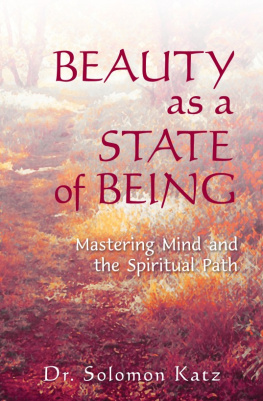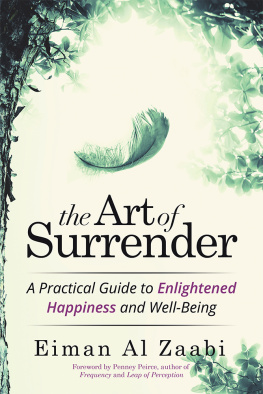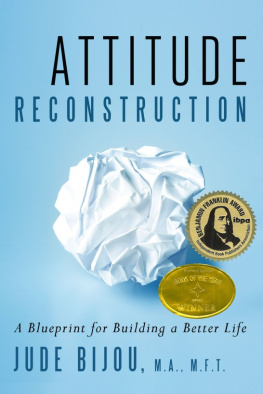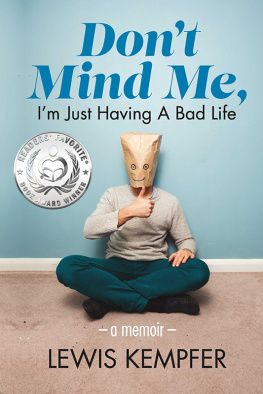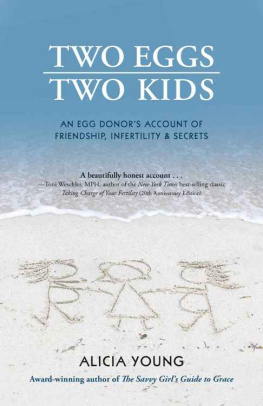BEAUTY
AS A
STATE OF
BEING
Mastering Mind
and the Spiritual Path
DR. SOLOMON KATZ
A DEEPER CURRENTS BOOK
Copyright 2013 by Solomon Katz
solomonkatz.com
Smashwords Edition
All rights reserved. This book may not bereproduced in whole or in part, stored in a retrieval system, ortransmitted in any form or by any means electronic, mechanical, orother without written permission from the author and copyrightowner, except by a reviewer, who may quote brief passages in areview.
Deeper Currents Press
Harvard, Massachusetts
TABLE OF CONTENTS
dedicated to the love locked in everyheart
waiting to be released
PREFACE
In a job interview at an institute for theintegration of psychology and religion I was once asked, Why haveyou gone outside your own religious tradition? They knew mybackground: my parents were Holocaust survivors steeped in OrthodoxJudaism. At the time of the interview, I practiced and supervisedin clinical psychology at a teaching hospital affiliated withHarvard Medical School, and I had done my graduate work at Harvardin psychology and religion. The question referred to my experienceprior to graduate school, when I lived as a Buddhist monk in Burmaand Sri Lanka.
My answer was honest: I never really feltmyself to be anything in particular. While I was a Buddhistmonk I did not consider myself a Buddhist. I never felt that anylabel quite hit the mark: Jewish, Buddhist, American, human being.Yes, of course but no, not exactly.
It turns out the sensibility I wasdescribing is itself a religious tradition: neti, neti notthis, not this the practice of negation rooted in the wisdom ofIndia. This practice endorses my innate tendency to negate all selfdefinitions. No label feels quite right for good reason: labels arealways incomplete and thus inaccurate.
Eventually, through negation, you come tothe fundamental reality that cannot be negated Being itself andthat you are. But you arrive there only after dispensingwith more superficial descriptions and identifications.
I bet the masters would agree. Greatspiritual teachers try to point toward reality, freedom, eternity.The Buddha is not trying to create Buddhists. Christ is not tryingto create Christians. Great teachers are interested in truth callit God, Nirvana, Self-Realization not in creating followers.
The great teachers, therefore, light theway. Because of my inclinations some teachings have rung truer thanothers, but this is a matter of taste as much as truth. Someteachings use language I am better able to understand, ideas withwhich I more deeply resonate, and so I am more deeply drawnthere.
While I was raised in the Western traditionsand could fluently read the Hebrew scriptures while sitting in anelementary school classroom, my primary influences are Eastern:Buddhism and the modern spiritual master, Ramana Maharshi, who diedin 1950.
Ramana is becoming ever more widelyrecognized as a spiritual genius of the highest order. In thepreface to Talks with Ramana Maharshi , KenWilber writes: Talks is the living voice of the greatest sage ofthe twentieth century and, arguably, the greatest spiritualrealization of this or any time.
I completely agree. Ramana offers among thepurest teachings ever expressed. For this reason, I will oftenquote from and use Ramana as a touchstone of truth.
A word about the structure and purpose ofthis book. This book aspires to be two things: a manual formastering the mind so as to progress along the spiritual path,finding greater happiness along the way; and a work of art. Assuch, the book employs various styles of writing. Some chapterswill carry the reader briskly along the spiritual path, as if youwere on a bus tour covering the terrain carefully laid out in theitinerary, with the tour guide explaining all the sights as theypass. At other times the tour pauses; you spill out of the bus tobrowse the gift shop at a notable landmark. The forward movementthen halts, and the writing changes from prose to something morelike poetry to be browsed and poetry will be interspersed withprose even in the forward moving chapters. My intent is to give thework greater power as a whole and, in the long run, greaterclarity. But sometimes clarity takes time to simmer. My hope is forthis book to stay with the reader, perhaps to be read more thanonce, perhaps to stay on the nightstand a while, or to be pulledoff the shelf years after the initial reading.
Didactics
My friend the painter and teacher ofpainting once told me,
that an artist need not lay everything outin the most obvious terms.
Some mystery should to be retained likethe Mona Lisa
some depth to ponder endlessly.
One purpose of art is to lead the viewer todepths,
that cannot be articulated;
depths that are beyond words, beyond theknown.
But in portraying this unknown, theart offers access to it.
This is the didactics of art, its mode ofinstruction.
Yet another mode of instruction
the didactics of science or philosophy,perhaps
is to be as clear as possible;
to look into the ambiguous, gleanclarity,
and then perfectly communicate the insightgained,
offering access to that same insight,
through a perfectly articulatedmap,
a precise formula that everyone canfollow,
leaving little to misunderstanding.
We tread here, dear reader, the tension,
between the didactics of clarity,
and the didactics of mystery.
CHAPTER I:
MIND
My colleague and I work in the field ofmental health. I work as a psychologist, she works as a psychiatricnurse practitioner, and we work together in a practice that weshare. Recently I was talking to her about a patient that I wasseeing. She asked, What is his diagnosis? I was inclined toanswer, He has the same diagnosis as everyone else that I see: Hehas a mind. Or I could have elaborated: He takes his thoughtsseriously. He is embedded in his thoughts. He believes theconversation going on in his head is significant. That is his and everyones diagnosis.
Clinical diagnoses like anxiety ordepression describe different patterns of mind, different ways themind may spin. Or the therapeutic focus might involve self-esteem,self-image, or self-doubt; other ways the mind may spin. The mindspins in many ways and its different preoccupations createdifferent emotional disturbances. But the bottom line, theuniversal diagnosis is always, He or she has a mind and it isspinning.
There is a slogan that says, A mind is aterrible thing to waste. Yes, but a mind can also be a terriblething. Obsessing with worry, fear, anxiety, depression, all theforms of unhappiness these are products of the mind. The conflictin the world anger, violence and war these are also products ofthe mind.
Having a mind is overrated. It needs to beused well or, possibly, not at all. Then there may be peace.
Power Tool
The mind is like a power tool, a chainsaw,for example. A chainsaw is very helpful when used for the purposesfor which it is designed. We heat our home with wood in the winter,and the seven cords of firewood seasoning all summer in the yardwould hardly be possible without a good chainsaw. But the chainsawmust be used properly and according to purpose or it can wreakhavoc. The mind too is powerful and capable of extraordinarycreativity and invention but, when used improperly, can become aninstrument of personal and global undoing.
Fingers and Buttons
Most people call a psychologist when theyare in turmoil. But what, really, is the problem? Certainly theaffairs of life may be in turmoil. There may be a crisis inpersonal relationships like loneliness or divorce. There may be ajob or financial loss, especially in times of economic distress.There may be physical illness. But it is imaginable that someoneeven facing death may be perfectly at peace or he may be in apanic.
Next page
